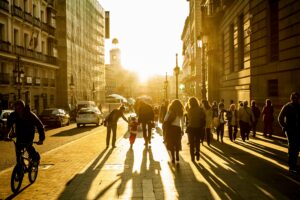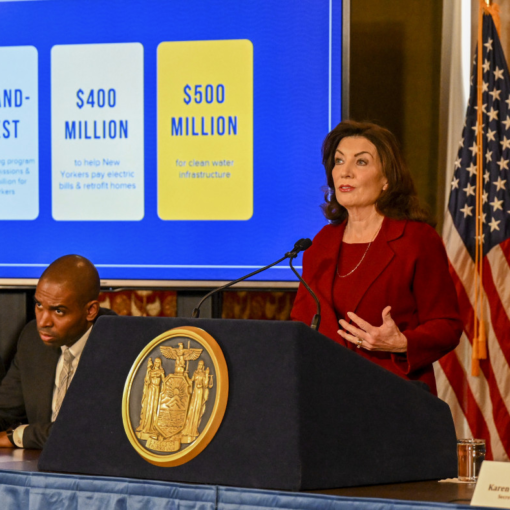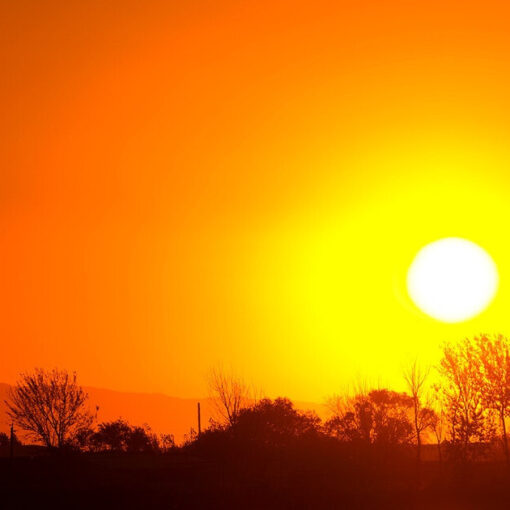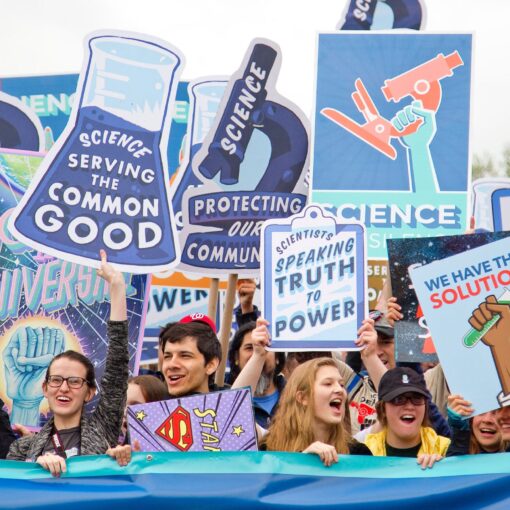
Every summer now feels like Groundhog Day. More heat records broken. Soon, we’ll have more school days canceled (take Philadelphia for example where nearly 30 percent of city schools recently shut down due to lack of cooling systems). We already have more heat-related deaths (in fact, according to a study, it’s very likely we’ve been undercounting them). And every summer, most cities use the same tools to try to help their residents stand (but not really beat) the heat. Smartphones are filled with “Code Red” texts and heat advisories from public officials who offer nothing more than cooling centers, hydration stations, water misters, and fans. But these short-term strategies fail to reach the root causes of record-breaking heat in cities. Worsening summer heat is a systematic threat requiring, instead, a more systematic solution that proactively cools cities down rather than just responding to higher temperatures.
Rising city heat is driven both by climate change and by the dark, impervious surfaces that have characterized the traditional city for too long. Typical residential and commercial roofs absorb 80 percent of sunlight, burning buildings and scorching neighborhoods. Roads, parking lots, and even playgrounds absorb 90 percent of sunlight, reaching temperatures of 160 degrees. Across whole neighborhoods these conditions bake communities and trigger a range of public health and public safety dangers.
In contrast, highly reflective “cool roofs” bounce back 80 percent of the sunlight that reaches them. Cool roofs are just one example of a suite of Smart Surfaces that combine reflective action with more trees, porous pavements, green surfaces, and solar panels to make cities far cooler, more aesthetically pleasing, and less prone to flooding.
Major cities are adopting a set of Smart Surface-driven cooling strategies developed by a national coalition of 40+ organizations known as the Smart Surfaces Coalition. These strategies treat all city surfaces as solutions for citywide cooling rather than a contributing factor to the urban heat island effect. To do this, surfaces like roofs and roads must be reflective to reduce the amount of heat absorbed in our neighborhoods, tree canopy must be expanded everywhere—especially in Black and Brown communities impacted the most from urban heat islands—and a robust mix of solar panels installed wherever viable. Increased “community solar,” a concept the state of New Jersey is piloting and expanding, would not only create new sources of energy and contribute to cooling, but dramatically reduce high energy bills felt by impacted Black and Brown residents. Together these strategies can cut summer heat in cities by more than 4°F.
The brutal reality of city heat today is that our neighborhood heat threats are extremely unequal. City underinvestment in trees, green spaces, and other essential and sustainable infrastructure is too often the norm in lower income and traditionally vulnerable Black and Brown communities. As a result, those areas are often 10°F or more hotter than higher income, predominantly White neighborhoods. Hence, heat inequity intensifies, reflecting the miserable racist past and present of unjust redlining decisions. Rev. Jon Robinson, Smart Surfaces Senior Program Director at Metropolitan A.M.E. church, a historic Black church based in Washington, D.C., calls this condition “ecological apartheid.”
In places like Baltimore, the difference between the wealthiest neighborhood and the lowest income one is stark: tree cover of 40 percent or more versus single digits—and a difference in summer afternoon peak temperature of up to 14 degrees. In response, the Baltimore city council recently worked with the Smart Surfaces Coalition and key partners such as the American Public Health Association and the National League of Cities to adopt a series of citywide Smart Surface bills. The most recent bill requires all new and retrofitted low-sloped roofs to quadruple reflectivity. When fully implemented, this single measure will cool the city by about 1.4°F—with the largest cooling in the hottest neighborhoods. Combined with other measures the city is taking on trees and urban meadows, the cooling benefits will be even greater.
And the benefits go on: in many cases, reflective surfaces cost no more than dark surfaces. As a result, these commonsense strategies are supported by city CFOs and businesses. They protect city credit ratings, increase employment, cut city energy bills and heat related health costs, all while making cities more resilient and livable—and they cool downtowns. This is key to protect tourism-related jobs and reduce loss of summer tourism due to rising heat.
Baltimore is just one of a dozen cities around the U.S., from Atlanta to Dallas and New Orleans to Boston, that are developing citywide Smart Surfaces to cool peak summer heat and protect their most vulnerable citizens. Cities around the world—from Medellin, Colombia to Singapore and many others in between—are similarly taking up actions to increase tree canopy, create “green corridors,” and otherwise use Smart Surfaces to find city-wide cooling benefits on the hottest days of summer. Alongside municipal action, groups like the Smart Surfaces Coalition and its partners are developing strategies for aligning government spending with cooling benefits, setting standards for indoor heat exposure, and forming funded public-private partnerships to transform neighborhoods.
The specific mechanisms that cities use to implement these strategies will inevitably vary. But the core concept of using all city surfaces to capture cost-effective, immediate benefits to city livability is applicable across widely varied city scales and climates. Dallas Mayor Eric Johnson argues that “leveraging this intelligent and cost-effective technology will cool our neighborhoods during hot Texas summers, reduce residents’ energy expenses, and minimize the impact of flash flooding events.”
These measures make cities much more livable and attractive while cutting the risk of flooding and mold. And critically, as Georges Benjamin MD, Executive Director of the American Public Health Association, argues: “These solutions combat climate change and improve health while advancing equity. It’s a win-win for all.” What are we waiting for?






